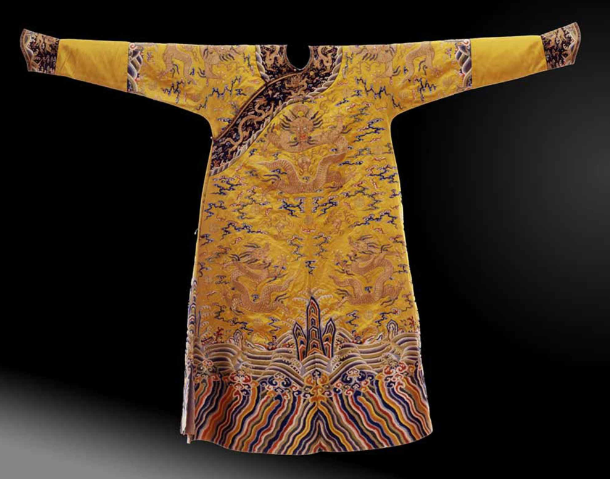Difference between revisions of "PEM E80968 Dragon robe, China (19th century)"
| Line 1: | Line 1: | ||
== Artifact Information == | == Artifact Information == | ||
| + | The Peabody Essex Museum in Salem, MA USA. E80968. | ||
| + | |||
| + | The Peabody Essex Museum collected a dragon robe (E80968) thought to have been produced for the late Qing dynasty court. Beginning in the seventeenth century, only the emperor, empress, empress dowager and sometimes a high-ranking imperial consort were permitted to wear garments in | ||
| + | this ‘bright’ or ‘clear’ shade of yellow, known in Chinese as ming huang [1]. The robe was probably made for a very high-ranking woman at court, if not the Emperor’s wife or mother. The height of the lishui wave border at the hem, in addition to the prominence of the dragons, stylistically place this robe in the middle of the nineteenth century. | ||
| − | |||
| − | |||
[[File:80968.PNG|center|frame|Image of Imperial dragon robe. © The Peabody Essex Museum in Salem, MA USA. ]] | [[File:80968.PNG|center|frame|Image of Imperial dragon robe. © The Peabody Essex Museum in Salem, MA USA. ]] | ||
Revision as of 13:29, 7 August 2017
Artifact Information
The Peabody Essex Museum in Salem, MA USA. E80968.
The Peabody Essex Museum collected a dragon robe (E80968) thought to have been produced for the late Qing dynasty court. Beginning in the seventeenth century, only the emperor, empress, empress dowager and sometimes a high-ranking imperial consort were permitted to wear garments in this ‘bright’ or ‘clear’ shade of yellow, known in Chinese as ming huang [1]. The robe was probably made for a very high-ranking woman at court, if not the Emperor’s wife or mother. The height of the lishui wave border at the hem, in addition to the prominence of the dragons, stylistically place this robe in the middle of the nineteenth century.
Summary of results
Yellow thread from the collar seam was samples and analyzed. The major components of the plant are flavonoids: rutin, keampferol and quecetin glycosides. The dyeing source was probably pagoda tree buds. [1]
HPLC profile
References
[1] Xian Zhang,Karina Corrigan, Bruce MacLaren, Mimi Leveque, and Richard A. Laursen, Characterization of Yellow Dyes in Nineteenth Century Chinese Textiles. Studies in Conservation 52, 211-220 (2007).

